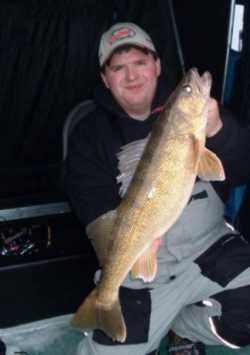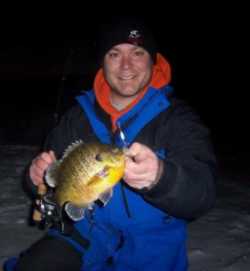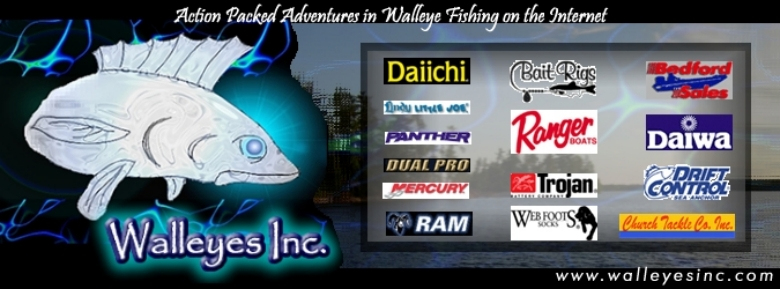Late ice patterns can very. People often preach
about fishing shallow. Others stress the importance of finding
moving water. Late ice is often hailed as the best fishing of
the year. The fish are supposed to be biting as well as they
have all winter. Anglers eagerly await the last hurrah. The
reality, however, is that fish can still be just about anywhere…
even during the late ice period.
We have found fish deep; we have found fish shallow. We have
seen where incoming current plated a factor and we have seen
where it did not. Throw in changing weather conditions and the
fact that different fish are on different programs not all reacting
to their changing environments at once and late ice fishing
is still just that… fishing. One big advantage for anglers
getting their last ice fishing fixes in is that the weather
is often very accommodating, allowing us to fish aggressively
outside of shelters and the days are long, giving us more time
to crack the pattern each day. Extreme fronts, blizzards and
lots of snow on the ice however still make fishing tough just
like any other time of the winter.
So don’t get hung up on shallow or deep. Don’t assume
that the fish will be suicidal. Don’t get hung up on certain
lakes or types of lakes. Systematically check different options
until the fish start to tell you that you are getting warm.
Here are a few of the different scenarios we have found over
and over again at first ice. Also, many of these patterns are
not species specific in the sense that this general milk run
of places to check has worked to find everything from bluegill
to walleye.

Northern wisconsin guide and pro staffer for Jason
Mitchell Elite Series Rods, Jim Hudson with an enormous
late ice walleye |
Where the Basin Meets the Bay
Many fish spawn in shallow bays that warm up quicker than
the main body or basin. Some fish need weeds, other gravel
or rock but the principals are the same. Come ice out
or shortly after, almost every fish in the lake makes
this push. Where the main basin connects to these shallower
bays where fish will eventually spawn is always worth
checking. This is often deep water but deep is relative.
This basin might be forty feet of twelve feet but regardless
of depth, don’t overlook where the basin meets the
bay.
Feeder Creeks, Dirty Ice and Shoreline Seepage
While the last pattern described may take you deep, an
option always worth looking at that takes you into very
shallow water and often close to shore. As the days get
longer and the sun starts to pound the ice hard enough
where you can throw a penny on the ice and watch the penny
melt through the ice, feeder creeks become more active,
snow begins to melt and creeps into the shorelines. To
find where this melt off is seeping into the lake along
the shoreline, look for dirty ice. Ice along the shore
might turn brown or yellow. The feeder creeks can often
be easy to identify on the shoreline and are marked on
most Lake Maps. A few different things seem to happen
that can make the fishing good. |
On clear lakes, this incoming water is often dirtier, which
might enable you to catch fish all day or at least for longer
windows in the morning and evening. This water is also rich
in oxygen. On small lakes where low oxygen levels combined with
deep snow put stress on fish, this pattern can be killer. At
times, this shallow blanket of shoreline water may be warmer
as well but we have actually found the exact opposite at times
with a temperature gauge. There are times where this water will
actually be colder than the water in the basin but the fish
were still up shallow along the shoreline regardless. Usually,
from our experiences, the shorelines are often soft with either
terrestrial vegetation growing along shore or perhaps cattails
or reeds. We usually didn’t find this shallow game going
on where the shorelines were rock. Last word of advice; don’t
wreck the blades on your auger because many of the best holes
are less than two feet out to about six feet, right tight to
shore.
|

Late ice offers a great opportunity to crack giant
panfish like this bull caught by Jason Mitchell Elite
Series Rod angler, Tony Marrioti from Otter Tail Minnesota |
Bottle Necks and Channels
Some fish appreciate current more than others. Sauger
and walleye for example seem to seek current, sauger especially
so. Panfish might not pile into areas where the flow is
obvious or strong but some movement of water seems to
have a universal appeal in varying degrees. On small flowages
and shallow lakes, bottleneck areas or boat channels often
concentrate fish. For panfish, perhaps bottleneck area
simply congest fish as they move through a system and
during late ice, many of these fish are indeed on the
move. Other situations, more so on big water, these narrows
often have strong currents that increase in intensity
as the days get longer and these strong current areas
are areas that walleye gather every spring. Channels are
always worth a look as well. Either where channels empty
into the lake or in the case of reservoirs, where the
reservoir turns to river, or channels connecting different
lake basins.
Green Weeds and New Growth
Green weeds are just universally appealing to most of
the fish we spend any time pursuing, from walleye and
pike to perch, sunfish and crappie. Some weeds just stay
green all winter long especially when there is little
or no snow. What often happens late in the winter however
is rejuvenation. Weeds that were browning up and breaking
down will sometimes begin to come back to life.
|
New green shoots begin to emerge and with this new vegetation
rebirth comes a second chance on many spots that were good at
first ice but went dead in the middle of winter. Usually, the
first weeds to green up are shallow where the water and ice
is generally clear on flats close to shore that feature darker
bottoms. Green weeds are just too good to pass up regardless
of time of year. Late ice is no exception.
Conclusion
There are many different patterns that can unfold as winter
progresses to spring. Every lake is different and lakes become
different as well over time. Add other anglers to the mix and
where we can expect to catch fish come late ice isn’t
so black and white. Many of the patterns described above may
take you shallow or deep, close to shore or away. Be flexible
and systematically eliminate different patterns that you know
can emerge, come late ice and you will enjoy finding fish a
few more times before the boat comes out of the garage.
Editors Note: The author, Jason Mitchell has been an Ice Team
Power Stick and legendary Perch Patrol guide on North Dakota’s
Devils Lake for several years and has designed a line up of
premier application specific ice rods, Jason Mitchell Elite
Series Rods, that are being heralded by many of the industries
top ice anglers. More information can be found at: www.jasonmitchellrods.com,
www.iceteam.com or www.perchpatrol.com
|

